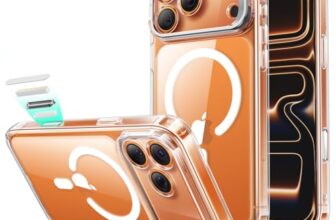The Apex of Bedroom Innovation: A 6000-Word Technical Benchmark of the King Size Multifunctional Smart Bed
The bedroom, once a purely utilitarian space dedicated to sleep, has undergone a profound transformation in the 21st century. It has evolved into a personal sanctuary—a multi-purpose haven for relaxation, entertainment, work, and rejuvenation. As our demands on this intimate space have grown, so too has the technology designed to enhance it. The evolution has moved beyond adjustable mattresses and ambient lighting to a new, fully integrated paradigm: the smart bed. This emerging category of furniture is not merely a place to sleep, but an active, interconnected platform that serves as the command center for modern rest and relaxation. It is the convergence of luxury upholstery, ergonomic science, and embedded digital technology.
At the pinnacle of this evolution stands the King Size Smart Multifunctional Bed Frame. This is not simply a bed; it is an ambitious, all-in-one ecosystem designed to cater to nearly every need of its occupant. It seamlessly fuses the roles of a therapeutic massage chair, a high-fidelity audio system, a convenient charging hub, and a high-capacity storage solution into a single, cohesive, and luxurious piece of furniture. It represents a fundamental rethinking of what a bed can be, positioning it as the true centerpiece of a modern, technologically integrated lifestyle. With its bold claims and comprehensive feature set, it stands as a top contender for the most advanced bedroom furniture system of 2025.
This review will serve as a comprehensive technical deep dive into this remarkable piece of engineering. We will move beyond its striking appearance to forensically analyze the mechanics, electronics, and materials that constitute its core. We will deconstruct the technology behind the integrated massage recliner, benchmark the performance of its Bluetooth audio system and charging station, and evaluate the materials science and structural engineering of the frame itself. Crucially, we will also provide a detailed, practical analysis of the self-installation process. This is an exhaustive benchmark intended to provide a clear, objective understanding of whether this smart bed delivers on its promise to be the ultimate luxury and technology hub for the modern bedroom.

Chapter 1: The Therapeutic Core – A Technical Analysis of the Integrated Massage Recliner
The most defining and technologically complex feature of this smart bed is the fully integrated, ergonomically designed massage lounge chair. This is not a simple vibrating cushion but a purpose-built system designed to deliver a therapeutic experience, transforming a section of the bed into a personal wellness device. Its design is rooted in the principles of ergonomics and relaxation science.
The Science of Ergonomics and Stress Reduction
The recliner’s geometry is engineered to support the natural curvature of the human spine, promoting proper posture and reducing strain on the lumbar region and neck. When in a reclined position, the body’s weight is more evenly distributed, which can help to alleviate pressure points and improve circulation. This physical relaxation is a precursor to mental stress reduction. By placing the body in a state of supported rest, the massage system can work more effectively to achieve its therapeutic goals.
The act of massage itself is designed to stimulate the parasympathetic nervous system, the body’s “rest and digest” system. This can help to lower heart rate, reduce levels of the stress hormone cortisol, and increase the production of endorphins, the body’s natural mood elevators. The goal of this integrated system is to provide a tool that can actively help the user unwind from the physical and mental stresses of the day, preparing the body for a more restorative night’s sleep.

Deconstructing the Massage Mechanism: A System of Zoned Vibration
While specifications for the internal mechanics are proprietary, we can make educated inferences based on the design and functionality of typical massage systems. The gentle, soothing massage described is likely achieved through a network of precisely placed vibration motors embedded within the recliner’s cushioning. Unlike shiatsu systems that use complex mechanical rollers, a high-frequency vibration system is ideal for a bed-integrated unit as it is quieter, more reliable, and can be housed in a much slimmer profile.
This system would likely be zonal, with multiple independent motors targeting key muscle groups:
- Upper Back & Shoulders: Motors in this zone would help to relieve tension often built up from sitting at a desk or driving.
- Lumbar Region: This is a critical zone for relieving lower back pain and stiffness.
- Thighs & Glutes: Vibration in this area can help to soothe tired leg muscles and improve circulation after a long day of standing or walking.
The remote control would then orchestrate these motors. Different massage programs could be created by varying the pattern, intensity, and frequency of the vibrations. For example, a “wave” mode might activate the motors sequentially from top to bottom, while a “pulse” mode might alternate the intensity of all motors simultaneously. The ability to control these variables allows the system to deliver a range of sensations, from a gentle, calming hum to a more invigorating, muscle-stimulating massage. The engineering challenge lies in mounting these motors in such a way that their vibrations are effectively transferred to the user without creating unwanted noise or rattling within the bed frame itself, a feat achieved through sophisticated internal damping and cushioning.
Control and Personalization at Your Fingertips
The entire therapeutic experience is governed by a dedicated remote control. This is a crucial element of the system’s technical design, as it provides a simple and intuitive user interface for a complex mechanical system. The remote allows for a high degree of personalization, which is key to its effectiveness. A user can typically select from pre-programmed massage routines or enter a manual mode to:
- Target Specific Zones: Activate only the lumbar motors to focus on lower back pain, for instance.
- Adjust Intensity Levels: Fine-tune the strength of the vibrations from a gentle flutter to a powerful pulsation, depending on their needs and sensitivity.
- Set Timers: An automatic shut-off timer is an important safety and convenience feature, allowing the user to relax and even doze off without needing to manually stop the massage.
This level of granular control ensures that the massage recliner is not a one-size-fits-all novelty but a customizable therapeutic tool that can be adapted to the specific needs of the user on any given day.
Chapter 2: The Integrated Entertainment and Technology Hub
Complementing its therapeutic features, the smart bed is equipped with an integrated infotainment and utility system designed to cater to the modern user’s connected lifestyle. This system effectively eliminates the clutter of bedside tables and turns the bed into a self-contained hub for entertainment and device management.
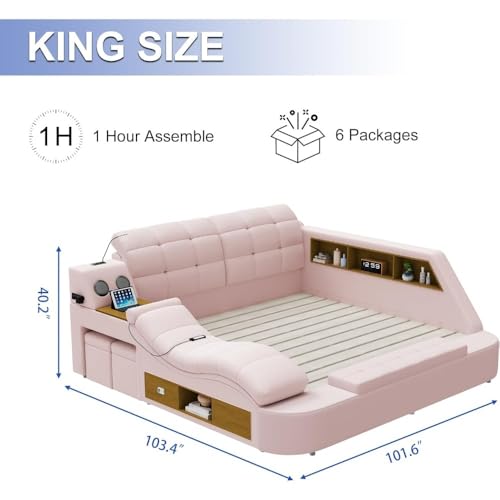
The Acoustic Environment: Integrated Dual Bluetooth Speakers
Embedded within the bed’s structure, likely in the headboard or side rails, is a stereo Bluetooth speaker system. The engineering goal of such a system is to create an immersive, near-field audio experience. By placing the speakers in close proximity to the listener’s ears, the system can achieve a clear and detailed stereo image without needing to be played at high volumes. This is ideal for late-night movie watching or listening to podcasts without disturbing a partner or the rest of the household.
Technically, these systems typically use a pair of full-range drivers, likely in the 2 to 3-inch range, powered by a compact Class D amplifier. Class D amplifiers are chosen for their high efficiency and low heat output, making them perfect for safe integration into upholstered furniture. The Bluetooth connectivity provides a universal and hassle-free method for streaming audio from any smartphone, tablet, or laptop. The “high sound quality” claim suggests that the acoustic enclosure around the drivers has been properly designed to prevent a thin, tinny sound, instead providing enough internal volume to reproduce a reasonably full and balanced audio profile suitable for casual listening and media consumption.
The Power Hub: The USB Charging Station
A simple yet profoundly useful feature is the integrated USB charging station. This component is a clear indicator of the bed’s design philosophy, which centers on modern convenience. The station likely includes two USB-A ports, each engineered to deliver a standard or fast-charging electrical current. A technical specification for such ports is typically 5 Volts at 2.1 or 2.4 Amps, which is sufficient to efficiently charge most modern smartphones and tablets. By building this functionality directly into the bed frame, the design eliminates the need for users to fish for charging cables and wall adapters behind a bedside table. It provides a clean, reliable, and always-accessible power source for the devices we use most, ensuring they are fully charged and ready for the day ahead.
Chapter 3: Materials Science, Structural Engineering, and Utility
Beyond its electronic features, this smart bed is a substantial piece of furniture. Its longevity, comfort, and practicality are dictated by the quality of its materials and the intelligence of its structural design.
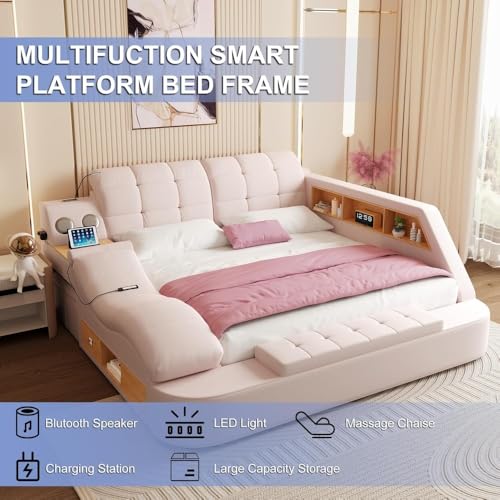
The Structural Skeleton: Frame and Support System
The foundation of the entire structure is its internal frame. To support the weight of a king-size mattress, multiple occupants, and the integrated machinery, this frame needs to be exceptionally robust. It is likely constructed from a combination of solid hardwood for key structural joints and load-bearing points, and high-grade, multi-layered plywood or MDF for the larger panels. This hybrid approach allows engineers to leverage the strength of solid wood while using the dimensional stability and warp-resistance of engineered wood for the broader surfaces. The mattress itself would be supported by a system of wooden slats. A quality slat system provides a firm, even base for the mattress and, crucially, allows for air circulation, which helps to regulate temperature and prevent the buildup of moisture and mildew within the mattress over time.
The Tactile Interface: Upholstery and Aesthetic Design
The bed is upholstered in a high-quality leather, likely a premium polyurethane (PU) leather. Modern PU leather is a sophisticated composite material engineered for a luxurious look and feel combined with superior durability and ease of maintenance compared to natural hide. It is resistant to scuffs, scratches, and fading, and can be easily cleaned with a damp cloth. The “simple and soft” design language points to a contemporary aesthetic characterized by clean lines, minimal ornamentation, and generously padded surfaces. The headboard, in particular, would be cushioned with high-density foam, providing a comfortable and supportive backrest for reading or watching television in bed.
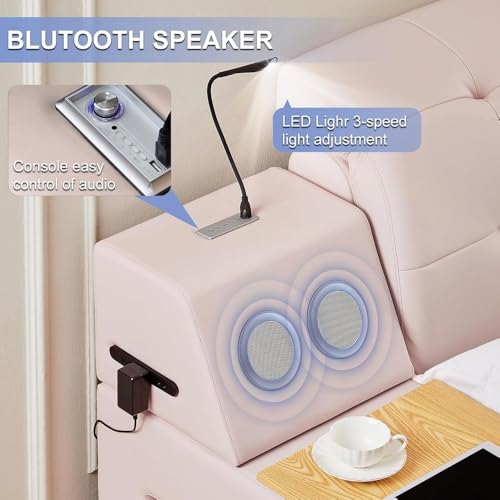
The Maximization of Space: Integrated Storage Solutions
A key aspect of the bed’s multifunctional design is its incorporation of a high-capacity storage system. In modern homes where space is often at a premium, this is a significant practical advantage. The design leverages the often-wasted space under and around the mattress platform. This includes:
- Under-bed Storage: This is likely the largest storage area, perfect for bulky items like spare duvets, blankets, and pillows. Access could be via large pull-out drawers integrated into the bed base.
- Side Storage: The images showcase integrated side compartments, shelves, and even small ottomans that can be stowed away. These are ideal for storing items you need more frequent access to, such as books, tablets, shoes, and other personal belongings.
From a design engineering perspective, this integration is highly efficient. It turns the single largest piece of furniture in the room into a multi-functional storage unit, maximizing the utility of the bedroom’s footprint and helping to keep the space organized and tidy.
Chapter 4: A Practical Guide to Assembly and Logistics
One of the most critical, and often overlooked, aspects of purchasing a large, complex piece of furniture online is the process of delivery and assembly. The manufacturer is transparent about this: **”Our beds needs to be installed by yourself.”** For a product of this size, complexity, and price, this is a major consideration that potential buyers must be fully prepared for.
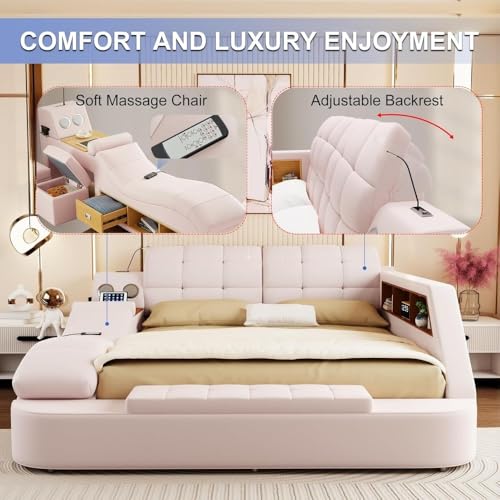
Managing Expectations: The Delivery and Unboxing Process
A king-size multifunctional bed frame will not arrive in a single box. Buyers should expect a freight delivery consisting of multiple, large, and very heavy packages. The total weight could easily be several hundred pounds. It is essential to have a clear path from the delivery point to the bedroom and to have at least two strong adults present to move the boxes. Unboxing should be done systematically in the room where the bed will be assembled to avoid having to move large, unwieldy individual pieces through doorways.
The Assembly Project: A Step-by-Step Overview
Assembling this bed is a significant DIY project that will require time, patience, and a methodical approach. While the provided instructions are the definitive guide, the process will likely follow these general stages:
- Inventory and Preparation: Before starting, all parts and hardware should be carefully unpacked and cross-referenced with the parts list in the instruction manual. This crucial first step ensures you have everything you need and prevents frustrating mid-assembly discoveries of missing components.
- Main Frame Construction: The first major step is typically the assembly of the core bed frame, including the headboard, footboard, and side rails that will support the mattress slats.
- Integration of Storage Units: The next stage would involve attaching the various side storage compartments, shelves, and ottoman units to the main frame.
- Assembly of the Massage Recliner: The massage recliner section may come as a semi-assembled module that needs to be secured into place and integrated with the main structure.
- Electronic Connections: This is the final and most delicate phase. It involves connecting the various electronic components—the massage motors, the USB hub, the Bluetooth speakers—to the central power supply and to each other. Careful cable management is key to ensuring a clean, safe, and functional setup.
Potential buyers should set aside a significant block of time, likely a full afternoon or even a weekend day, for this project. While the manufacturer provides support for installation issues, this is not a task to be rushed. It should be approached as a rewarding, albeit challenging, project—the final step in creating a truly personalized bedroom sanctuary.
Final Technical Analysis and Verdict
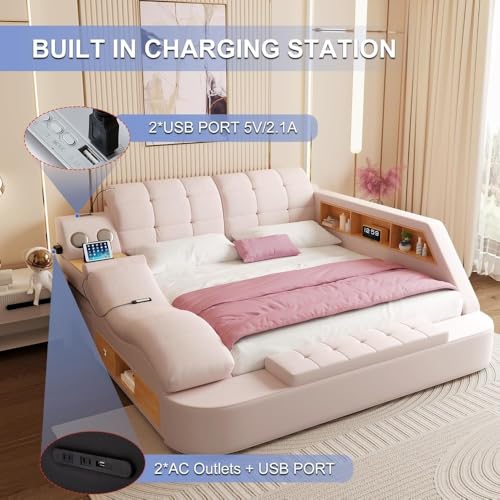
Pros: Key Engineering Strengths
- Unparalleled System Integration: The seamless fusion of a therapeutic massage recliner, audio system, charging station, and high-capacity storage into a single unit is a remarkable feat of design.
- Advanced Therapeutic Features: The zoned, remote-controlled massage system is a genuinely useful wellness tool for stress reduction and muscle relaxation.
- Robust Construction: The use of a hybrid wood frame and durable, high-quality leather upholstery points to a product designed for longevity.
- Modern Tech Convenience: Integrated Bluetooth audio and USB charging are essential features for a connected lifestyle, and their inclusion is well-executed.
- High-Efficiency Design: The massive amount of integrated storage makes it an incredibly space-efficient piece of furniture, maximizing the utility of the bedroom’s footprint.
Cons: Technical and Practical Considerations
- Complex Self-Assembly: The requirement for self-installation is a major hurdle and may be beyond the comfort level or capability of some buyers. Professional assembly would be a significant additional cost.
- High Price Point: This is a significant luxury investment, placing it in a niche market.
- Weight and Portability: Once assembled, the bed will be extremely heavy and virtually impossible to move without significant disassembly, making it unsuitable for those who move frequently.
- Proprietary Components: The integrated electronics (massage motors, speakers, USB hub) are proprietary. If a single component fails out of warranty, repair or replacement could be difficult and costly.
Conclusion: The Definitive Hub for the Modern Smart Bedroom
After a thorough technical benchmark, the King Size Smart Multifunctional Bed Frame establishes itself as more than just a piece of furniture; it is a fully realized, integrated lifestyle platform. It is a bold and successful execution of the concept of the modern bedroom as a multi-purpose sanctuary. The engineering required to seamlessly combine a robust structural frame, a complex therapeutic massage system, a complete infotainment hub, and a vast storage solution into one aesthetically pleasing unit is truly impressive.
This is, without question, a luxury product aimed at a specific type of consumer: the tech-savvy individual who values ultimate convenience and integrated comfort, and who sees their bedroom as the central hub for their relaxation and personal time. The significant investment in price is matched by an unparalleled feature set that transforms the very function of a bed. While the challenge of self-assembly is a serious consideration that must be carefully weighed, for the right buyer who is prepared for the project, the reward is immense. It is the creation of a personalized haven that caters to nearly every modern need. For its ambitious design and successful integration of technology and comfort, this smart bed stands as a definitive, top-tier luxury bedroom product for 2025.
See more posts in the category House.
![Smart Bed Frame [2025] In-Depth Technical Review & Performance Benchmark](https://odvex.com/wp-content/uploads/2025/10/81QX4NBYo-L-350x350.jpg)
![Smart Bed Frame [2025] In-Depth Technical Review & Performance Benchmark](https://odvex.com/wp-content/uploads/thumbs_dir/418pJonn4S-rd8cruyo5o6mcrofo7mcwdxyqwgdaz3329ew2486rg.jpg)
![Smart Bed Frame [2025] In-Depth Technical Review & Performance Benchmark](https://odvex.com/wp-content/uploads/thumbs_dir/31fZivvRq3L-rd8e8qdul6k9f4vlxkdvnjmdo5una1zjbyh4vftyrg.jpg)



